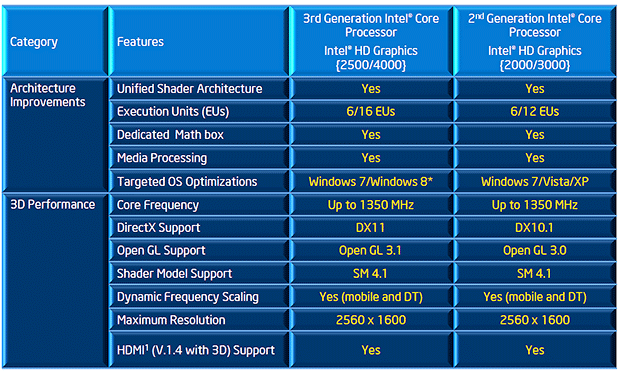Intel Core i7-3770K Ivy Bridge Processor Review
New HD Graphics and Media Encoding
Ivy Bridge based 3rd Generation Intel Core processors will feature one of two graphics core configurations, Intel HD Graphics 2500 or Intel HD Graphics 4000. The two differ only in their number of execution units, or cores. Intel HD Graphics 2500 will have 6 EUs enabled, while HD 4000 Graphics will have 16---the previous-gen HD Graphics 3000 engine in Sandy Bridge had a maximum of 12 EUs. The graphics cores on the different processors will also differ in their peak frequencies as well. For example, the Core i5-3450 will have a peak graphics core frequency of 1100MHz, while the graphics engine in the Core i7-3770K we’ll be showing you here can Turbo up to 1150MHz.

Intel HD Graphics Engine Feature Comparison (1350MHz GPU, for mobile only)
All Ivy Bridge based K SKUs and some higher end Core i7 and i5-branded chips will feature the more powerful Intel HD Graphics 4000 core. Non-K SKUs will feature Intel HD Graphics 2500, which is essentially an HD 2000 engine with DX11 support or an HD 4000 with 10 of its execution units disabled. If you ask us, this is somewhat backwards, as was the case with Sandy Bridge. We think it’s more likely that K SKU buyers will pair their processors to discrete GPUs, whereas standard CPU buyers are more likely to use integrated graphics. You’d think it would be more beneficial if the standard CPUs got the faster graphics configurations, because they’re more likely to get used by the consumers who’d buy those chips. Regardless, the biggest changes to come with the new graphics engine in Ivy Bridge are support for DirectX 11 and OpenGL 3.1, support for up to three display outputs, and the enhanced Quick Sync Video engine.

2nd Gen Core = Sandy Bridge, 3rd gen Core = Ivy Bridge
Features of the new Intel graphics core include stereoscopic 3D support, dubbed InTru 3D, Clear Video HD for image quality enhancement, WiDi (Wireless Display), and Quick Sync, the integrated media processing engine for hardware accelerated Encoding, Decoding and Transcoding Intel which debuted with Sandy Bridge. With Ivy Bridge, however, Quick Sync’s compute resources have been essentially doubled and it offers much better performance.
If you’re unfamiliar with Quick Sync, it works much like the GPU accelerated Encoding, Decoding and Transcoding we’ve seen from NVIDIA and AMD and offers vastly increased performance over software only-based solutions. Like NVIDIA’s and AMD’s offerings, software vendors will have to specifically code for Intel Quick Sync technology, but most of the major players in the space are doing so. We test Quick Sync with Cyberlink’s MediaShow Espresso a little later in this article.
As you’ll see, we found Intel’s Quick Sync technology to offer exceptional performance, but there is a significant caveat. Users must be utilizing the processor’s integrated graphics core to take advantage of Quick Sync. If a discrete graphics card is installed in the system and a single monitor is attached to it, the processor’s integrated Intel HD Graphics 2500/4000 core is disabled, with Quick Sync along with it. There are workarounds, though. LucidLogix’s Virtu GPU-virtualization software gives users the ability to use both Intel’s integrated graphics and a discrete GPU. Or you could connect monitors to both the discrete and integrated graphics engines.






